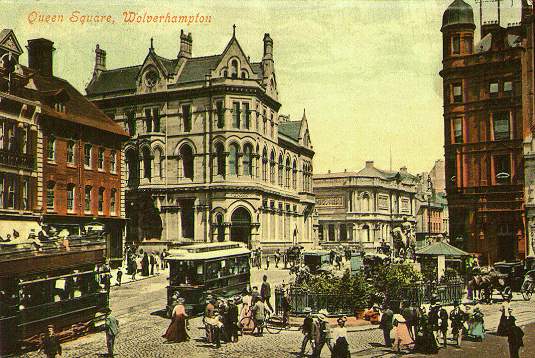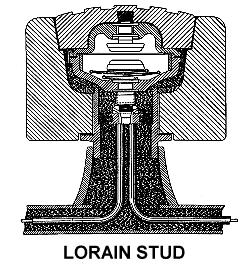

This postcard showing Queen Square at the busy centre of Wolverhampton, was published locally by the stationer George Goodwin and posted on 2nd June 1906.
In Wolverhampton the 3ft. 6in. gauge electric tramway using surface contact stud current collection had replaced the former standard gauge horse tramway, with the first runs between the depot in Cleveland Road and Ettingshall Road starting on 6th February 1902. This was extended from Cleveland Road into the town centre on 30th April 1902. The first major route across town to New Hampton Road, Whitmore Reans, began on 1st May 1902, the opening day of the Wolverhampton Art and Industrial Exhibition in nearby West Park.
Alderman Charles Mander, chairman of the Wolverhampton Tramways Committee, was strongly opposed to overhead wires. However, after a quick look at the Dolter stud system (see Hastings postcard), the council decided to adopt the alternative Lorain system. The Lorain stud was the invention of American William Milton Brown of Johnstown, Pennsylvania, who briefly used them in 1898 on the Washington and Congress Heights Railway. In 1895, his first (of many) patent rights were assigned to the Johnson Company of Lorain, Ohio which around 1899 became the Lorain Steel Company of Ohio (and of Pittsburgh, Pennsylvania from around 1900), who manufactured the Wolverhampton studs and for whom Brown was working until at least 1905. During 1903 Brown was based at Cleveland Road, Wolverhampton.
A power supply cable was laid between the tracks in a wooden trough filled with bitumen, joining together the studs which were attached by brass plugs and sockets to allow easy removal for maintenance. Each tram had fixed to it a skate consisting of three skids. The outside two were 16ft long, were fixed two inches above the road and were magnetised by six pairs of powerful electromagnets connected by iron strips and energised by the traction power supply, but with a rechargeable battery backup to energise the first stud after power disconnection. The batteries were re-charged from the power supply line but in practice were removed from the cars and re-charged overnight in the depot. The centre skid was made of phosphor-bronze and was 12 ft long, was insulated from the car body by means of a wooden support and a longitudinal flexible rubber tube which pressed the skid into electrical contact with the studs. Being shorter than the magnetic skids ensured that a stud was always live before the pickup skid reached it and after it left it, to avoid arcing occurring inside the stud. Earthed lightweight chains hanging from the ends of the car made contact with each stud as the car passed, so that any stud remaining live would be short circuited and a fuse blown.
 Each stud itself was 12.75" x 6.75" and was made of a cast iron head with a renewable non-magnetic manganese steel centre insert. These were bolted down to reconstructed granite blocks, (described in a patent of 1898 as asphaltum sic), set between the rails 10ft apart, closer on hills and curves and projecting 3/4" above the road surface. Inside was a movable soft iron strip forming an armature, joined to the power supply by a "Z" shaped 1.5" wide copper-strip spring which also held the armature away from the stud head. Carbon contacts were fitted to the top of the armature and to the underside of the stud head. This mechanism was all contained in an insulated cup surrounded by insulating oil. As the magnetic skate on the tram passed over the stud, the armature was attracted upwards to the stud head, completing the electrical circuit. On passing the armature parted from the stud head and broke the circuit.
Each stud itself was 12.75" x 6.75" and was made of a cast iron head with a renewable non-magnetic manganese steel centre insert. These were bolted down to reconstructed granite blocks, (described in a patent of 1898 as asphaltum sic), set between the rails 10ft apart, closer on hills and curves and projecting 3/4" above the road surface. Inside was a movable soft iron strip forming an armature, joined to the power supply by a "Z" shaped 1.5" wide copper-strip spring which also held the armature away from the stud head. Carbon contacts were fitted to the top of the armature and to the underside of the stud head. This mechanism was all contained in an insulated cup surrounded by insulating oil. As the magnetic skate on the tram passed over the stud, the armature was attracted upwards to the stud head, completing the electrical circuit. On passing the armature parted from the stud head and broke the circuit.
The initial 1902 Wolverhampton rolling stock consisted a mixture of single deck combination cars, single deck open combination cars (but later enclosed), and double deck open top 4-wheelers. The first one of each type was constructed by the Electric Railway and Tramway Carriage Works of Preston on Brill 21E trucks, the remaining 21 by G.F.Milnes and Co. on Lorain-DuPont trucks. The livery was dark green and gamboge. More similar cars were soon added from Milnes and the United Electric Car Company of Preston.
The system and fleet continued to expand until just before the 1st World War. After the war, wear and tear and lack of spares forced a change to the overhead wire system which began with Dudley Road, 26th March 1921. The last route converted was the last to open (in 1909), the Penn Fields route, operating on the overhead from 15th October 1921. Although 17 new trams from English Electric and Brush were added in the early 1920s, trolleybus operation soon replaced trams to Wednesfield (only converted to overhead on 28th July 1921) on 29th October 1923 and the last Wolverhampton tram ran to Bilston on 26th August 1928, with the trolleybuses themselves being withdrawn on 5th March 1967.
![]() Go to Postcard Of The Month Index
Go to Postcard Of The Month Index